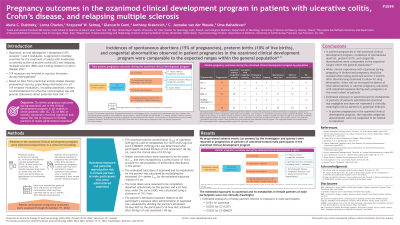Tuesday Poster Session
Category: IBD
P3599 - Pregnancy Outcomes in the Ozanimod Clinical Development Program in Patients with Ulcerative Colitis, Crohn’s Disease, and Relapsing Multiple Sclerosis
Tuesday, October 24, 2023
10:30 AM - 4:00 PM PT
Location: Exhibit Hall

Has Audio

Marla C. Dubinsky, MD
Mount Sinai Kravis Children’s Hospital
New York, NY
Presenting Author(s)
Marla C. Dubinsky, MD1, Lorna Charles, PhD2, Krzysztof W. Selmaj, PhD3, Giancarlo Comi, MD4, Anthony Krakovich, MD, MPH2, C. Janneke van der Woude, MD, PhD5, Uma Mahadevan, MD6
1Mount Sinai Kravis Children’s Hospital, New York, NY; 2Bristol Myers Squibb, Princeton, NJ; 3Center for Neurology, Lodz, Poland, and Collegium Medicum, University of Warmia and Mazury, Olsztyn, Opolskie, Poland; 4Vita-Salute San Raffaele University and Casa di Cura del Policlinico, Milan, Lombardia, Italy; 5Erasmus University Medical Center, Rotterdam, Drenthe, Netherlands; 6University of California San Francisco, San Francisco, CA
Introduction: Ozanimod is an oral sphingosine 1-phosphate (S1P) receptor 1 and 5 modulator approved in multiple countries for the treatment of adults with moderately to severely active ulcerative colitis (UC) and relapsing multiple sclerosis (RMS). Ozanimod is also being studied in the treatment of Crohn’s disease (CD). S1P receptors are involved in vascular formation during embryogenesis, and prescribing information for S1P receptor modulators, such as ozanimod, contain recommendations for effective contraception use as well as general statements about potential fetal risk based on data from preclinical studies.
Methods: The objective of this analysis was to review pregnancy outcomes during ozanimod use in the clinical development program in all studies in which patients with UC, CD, or RMS or healthy volunteers received ozanimod. Within studies in the ozanimod clinical development program, female patients of childbearing potential were required to use effective contraception while receiving ozanimod and for up to 3 months after discontinuing the drug; treatment discontinuation was required when pregnancy was confirmed. Pregnancy outcomes in the ozanimod clinical development program were assessed through November 19, 2022.
Results: In ozanimod clinical trials, 78 patient pregnancies occurred: 14 in those with UC, 6 in those with CD, 57 in those with RMS (there were 58 outcomes due to twins), and 1 in a healthy volunteer (Table). All patient pregnancy exposures to ozanimod occurred during the first trimester. Patients discontinued study medication promptly after pregnancy was confirmed, except for those who elected pregnancy termination and remained on study medication. The incidence of spontaneous abortion in clinical trial patients was 15%. The preterm birth rate was 10% of all live births. Outcomes in patients with UC included 7 live births (no congenital abnormalities or premature births), 3 spontaneous early losses, and 4 elective terminations (Table). No teratogenicity was observed in patients with ozanimod exposure during early pregnancy.
Discussion: Pregnancy should be avoided in patients receiving ozanimod and for 3 months after discontinuing ozanimod. Clinical experience with ozanimod during pregnancy is limited. In this small cohort of patients, there has been no increased incidence of fetal abnormalities or adverse pregnancy outcomes seen with ozanimod exposure in early pregnancy.
Disclosures:
Marla C. Dubinsky, MD1, Lorna Charles, PhD2, Krzysztof W. Selmaj, PhD3, Giancarlo Comi, MD4, Anthony Krakovich, MD, MPH2, C. Janneke van der Woude, MD, PhD5, Uma Mahadevan, MD6. P3599 - Pregnancy Outcomes in the Ozanimod Clinical Development Program in Patients with Ulcerative Colitis, Crohn’s Disease, and Relapsing Multiple Sclerosis, ACG 2023 Annual Scientific Meeting Abstracts. Vancouver, BC, Canada: American College of Gastroenterology.
1Mount Sinai Kravis Children’s Hospital, New York, NY; 2Bristol Myers Squibb, Princeton, NJ; 3Center for Neurology, Lodz, Poland, and Collegium Medicum, University of Warmia and Mazury, Olsztyn, Opolskie, Poland; 4Vita-Salute San Raffaele University and Casa di Cura del Policlinico, Milan, Lombardia, Italy; 5Erasmus University Medical Center, Rotterdam, Drenthe, Netherlands; 6University of California San Francisco, San Francisco, CA
Introduction: Ozanimod is an oral sphingosine 1-phosphate (S1P) receptor 1 and 5 modulator approved in multiple countries for the treatment of adults with moderately to severely active ulcerative colitis (UC) and relapsing multiple sclerosis (RMS). Ozanimod is also being studied in the treatment of Crohn’s disease (CD). S1P receptors are involved in vascular formation during embryogenesis, and prescribing information for S1P receptor modulators, such as ozanimod, contain recommendations for effective contraception use as well as general statements about potential fetal risk based on data from preclinical studies.
Methods: The objective of this analysis was to review pregnancy outcomes during ozanimod use in the clinical development program in all studies in which patients with UC, CD, or RMS or healthy volunteers received ozanimod. Within studies in the ozanimod clinical development program, female patients of childbearing potential were required to use effective contraception while receiving ozanimod and for up to 3 months after discontinuing the drug; treatment discontinuation was required when pregnancy was confirmed. Pregnancy outcomes in the ozanimod clinical development program were assessed through November 19, 2022.
Results: In ozanimod clinical trials, 78 patient pregnancies occurred: 14 in those with UC, 6 in those with CD, 57 in those with RMS (there were 58 outcomes due to twins), and 1 in a healthy volunteer (Table). All patient pregnancy exposures to ozanimod occurred during the first trimester. Patients discontinued study medication promptly after pregnancy was confirmed, except for those who elected pregnancy termination and remained on study medication. The incidence of spontaneous abortion in clinical trial patients was 15%. The preterm birth rate was 10% of all live births. Outcomes in patients with UC included 7 live births (no congenital abnormalities or premature births), 3 spontaneous early losses, and 4 elective terminations (Table). No teratogenicity was observed in patients with ozanimod exposure during early pregnancy.
Discussion: Pregnancy should be avoided in patients receiving ozanimod and for 3 months after discontinuing ozanimod. Clinical experience with ozanimod during pregnancy is limited. In this small cohort of patients, there has been no increased incidence of fetal abnormalities or adverse pregnancy outcomes seen with ozanimod exposure in early pregnancy.
Disclosures:
Marla Dubinsky: AbbVie – Consultant, Grant/Research Support. Arena Pharmaceuticals – Consultant. Astra Zeneca – Consultant. Celgene – Consultant. Genentech Inc. – Consultant. Gilead Sciences – Consultant. Janssen – Consultant, Grant/Research Support. Merck – Consultant. Pfizer – Consultant, Grant/Research Support. Prometheus Biosciences – Consultant, Grant/Research Support. Prometheus Labs – Consultant, Grant/Research Support. Takeda – Consultant, Licensing fees. Thabor – Consultant. Trellus Health – Stock-publicly held company(excluding mutual/index funds). UCB Pharma – Consultant.
Lorna Charles: Bristol Myers Squibb – employee and/or shareholder.
Krzysztof W. Selmaj: Biogen – Consultant. Celgene – Consultant. Genzyme – Consultant. Merck – Consultant. Novartis – Consultant. Ono Pharma – Consultant. Roche – Consultant. Synthon – Consultant. Teva – Consultant.
Giancarlo Comi: Almirall – Consultant, Speakers Bureau. Biogen – Consultant, Speakers Bureau. Celgene – Consultant, Speakers Bureau. EXCEMED – Consultant, Speakers Bureau. Forward Pharma – Consultant, Speakers Bureau. Genzyme – Consultant, Speakers Bureau. Merck – Consultant, Speakers Bureau. Novartis – Consultant, Speakers Bureau. Roche – Consultant, Speakers Bureau. Sanofi – Consultant, Speakers Bureau. Teva – Consultant, Speakers Bureau.
Anthony Krakovich: Bristol Myers Squibb – employee and/or shareholder.
C. Janneke van der Woude: AbbVie – Advisory Committee/Board Member, Grant/Research Support, Speakers Bureau. Celltrion – Advisory Committee/Board Member, Grant/Research Support, Speakers Bureau. Dr. Falk Pharma Benelux – Advisory Committee/Board Member, Grant/Research Support, Speakers Bureau. Falk Ben-elux – Grant/Research Support. Ferring – Advisory Committee/Board Member, Grant/Research Support, Speakers Bureau. Janssen – Advisory Committee/Board Member, Grant/Research Support, Speakers Bureau. Pfizer – Advisory Committee/Board Member, Grant/Research Support, Speakers Bureau. Takeda – Advisory Committee/Board Member, Grant/Research Support, Speakers Bureau.
Uma Mahadevan: AbbVie – Consultant. Boehringer Ingelheim – Consultant. Bristol Myers Squibb – Consultant. Celltrion – Consultant. Eli Lilly – Consultant. Gilead – Consultant. Janssen – Consultant. Pfizer – Consultant. Prometheus Biosciences – Consultant. Protagonist Therapeutics – Consultant. Rani Therpeutics – Consultant. Roivant – Consultant. Takeda – Consultant.
Marla C. Dubinsky, MD1, Lorna Charles, PhD2, Krzysztof W. Selmaj, PhD3, Giancarlo Comi, MD4, Anthony Krakovich, MD, MPH2, C. Janneke van der Woude, MD, PhD5, Uma Mahadevan, MD6. P3599 - Pregnancy Outcomes in the Ozanimod Clinical Development Program in Patients with Ulcerative Colitis, Crohn’s Disease, and Relapsing Multiple Sclerosis, ACG 2023 Annual Scientific Meeting Abstracts. Vancouver, BC, Canada: American College of Gastroenterology.
